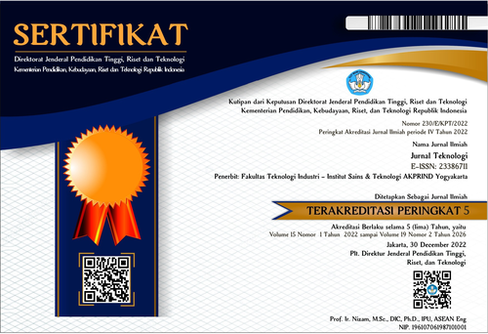Analisis Perbandingan Optimizer pada Arsitektur NASNetMobile Convolutional Neural Network untuk Klasifikasi Ras Kucing
DOI:
https://doi.org/10.34151/jurtek.v15i2.4025Keywords:
cat breed classification, convolutional neural network, deep learning, NASNetMobile, optimizerAbstract
Searching for research titles and abstracts is made easy with these keywords. Artificial Intelligence (AI) technology is currently developing very rapidly, there are various applications of AI that we can find in everyday life around us without realizing it. AI technology now allows us to work with computers more easily, just as we can know the type of cat breed and other information. There is deep learning that works by imitating the human brain or artificial neural networks to enhance current machine-learning capabilities. Deep learning can recognize and classify image categories. This study aims to determine the optimal optimizer in the classification of cat breeds. With the classification of cat breeds, cat keepers can find out the type of cat breed so they can find out how to care for it, the activities, and the personality possessed by the cat. The use of algorithm method used in this study uses the CNN algorithm with the NASNetMobile architecture. The dataset contains 840 images which are divided into 4 classes and divided into 588 training data, 168 testing data, and 84 validation data. for the RMSprop optimizer with a learning rate of 0.0001 to get an accuracy of 89.88%, this result is the highest among the others. Meanwhile, the SGD optimizer gets an accuracy of 78.57 & this result is the lowest. So it can be concluded that the architecture and optimizer are very important and influential in improving the performance of the model.
Downloads
References
P. A., Mapayi, T., & Tu, C. (2022). Intelligent Mobile Plant Disease Diagnostic System Using NASNet-Mobile Deep Learning. IAENG International Journal of Computer Science, 49(1), 216–231.
Amiruddin, B. P., & Kadir, R. E. A. (2020). CNN Architectures Performance Evaluation for Image Classification of Mosquito in Indonesia. Proceedings - 2020 International Seminar on Intelligent Technology and Its Application: Humanification of Reliable Intelligent Systems, ISITIA 2020, 223–227. https://doi.org/10.1109/ISITIA49792.2020.9163732
Bera, S., & Shrivastava, V. K. (2020). Analysis of various optimizers on deep convolutional neural network model in the application of hyperspectral remote sensing image classification. International Journal of Remote Sensing, 41(7), 2664–2683. https://doi.org/10.1080/01431161.2019.1694725
Crowell-Davis, S. L., Curtis, T. M., & Knowles, R. J. (2004). Social organization in the cat: A modern understanding. Journal of Feline Medicine and Surgery, 6(1), 19–28. https://doi.org/10.1016/j.jfms.2003.09.013
Imanuel, A., & Setiabudi, D. H. (n.d.). Penerapan Convolutional Neural Network dengan Pre-Trained Model Xception untuk Meningkatkan Akurasi dalam Mengidentifikasi Jenis Ras Kucing. www.kaggle.com
Jaka, K., Abwabul, J., Muhammad Zulkarnain, L., Rubianto, & Rika, R. (2022). Komparasi Algoritma Support Vector Machine Dan Naive Bayes Pada Klasifikasi Ras Kucing. Jurnal Generic, 14(1), 8–12. http://generic.ilkom.unsri.ac.id/index.php/generic/article/view/122
Karlita, T., Choirunisa, N. A., Asmara, R., & Setyorini, F. (2022). Cat Breeds Classification Using Compound Model Scaling Convolutional Neural Networks. Proceedings of the International Conference on Applied Science and Technology on Social Science 2021 (ICAST-SS 2021), 647, 909–914. https://doi.org/10.2991/assehr.k.220301.150
Lipinski, M. J., Froenicke, L., Baysac, K. C., Billings, N. C., Leutenegger, C. M., Levy, A. M., Longeri, M., Niini, T., Ozpinar, H., Slater, M. R., Pedersen, N. C., & Lyons, L. A. (2008). The ascent of cat breeds: Genetic evaluations of breeds and worldwide random-bred populations. Genomics, 91(1), 12–21. https://doi.org/10.1016/j.ygeno.2007.10.009
Menotti-Raymond, M. A., & O’Brien, S. (1995). Evolutionary conservation of ten microsatellite loci in four species of felidae. Journal of Heredity, 86(4), 319–322. https://doi.org/10.1093/oxfordjournals.jhered.a111594
O’Brien, S. J., Johnson, W., Driscoll, C., Pontius, J., Pecon-Slattery, J., & Menotti-Raymond, M. (2008). State of cat genomics. Trends in Genetics, 24(6), 268–279. https://doi.org/10.1016/j.tig.2008.03.004
Purnama, I. N. (2020). Herbal Plant Detection Based on Leaves Image Using Convolutional Neural Network With Mobile Net Architecture. JITK (Jurnal Ilmu Pengetahuan Dan Teknologi Komputer), 6(1), 27–32. https://doi.org/10.33480/jitk.v6i1.1400
Radhika, K., Devika, K., Aswathi, T., Sreevidya, P., Sowmya, V., & Soman, K. P. (2020). Performance analysis of NASNet on unconstrained ear recognition. Studies in Computational Intelligence, SCI 871, 57–82. https://doi.org/10.1007/978-3-030-33820-6_3
Vani, S., & Rao, T. V. M. (2019). An experimental approach towards the performance assessment of various optimizers on convolutional neural network. Proceedings of the International Conference on Trends in Electronics and Informatics, ICOEI 2019, Icoei, 331–336. https://doi.org/10.1109/ICOEI.2019.8862686
Wikarta, A., Sigit Pramono, A., & Ariatedja, J. B. (2020). Analisa Bermacam Optimizer Pada Convolutional Neural Network Untuk Deteksi Pemakaian Masker Pengemudi Kendaraan. Seminar Nasional Informatika, 2020(Semnasif), 69–72.
Zhang, Q., Zhang, M., Chen, T., Sun, Z., Ma, Y., & Yu, B. (2019). Recent advances in convolutional neural network acceleration. Neurocomputing, 323, 37–51. https://doi.org/10.1016/j.neucom.2018.09.038
Downloads
Published
How to Cite
Issue
Section
License
Copyright (c) 2022 D. Diffran Nur Cahyo, Muhammad Anwar Fauzi, Jangkung Tri Nugroho, Kusrini

This work is licensed under a Creative Commons Attribution 4.0 International License.
Jurnal Teknologi provides immediate open access to its content in order of making research freely available to the public to support a global exchange of knowledge. All articles published in this journal are free for everyone to read and download, under licence CC BY SA.
Benefits of open access for the author, include:
- Free access for all users worldwide.
- Authors retain copyright to their work.
- Increased visibility and readership.
- No spatial constraints.




















